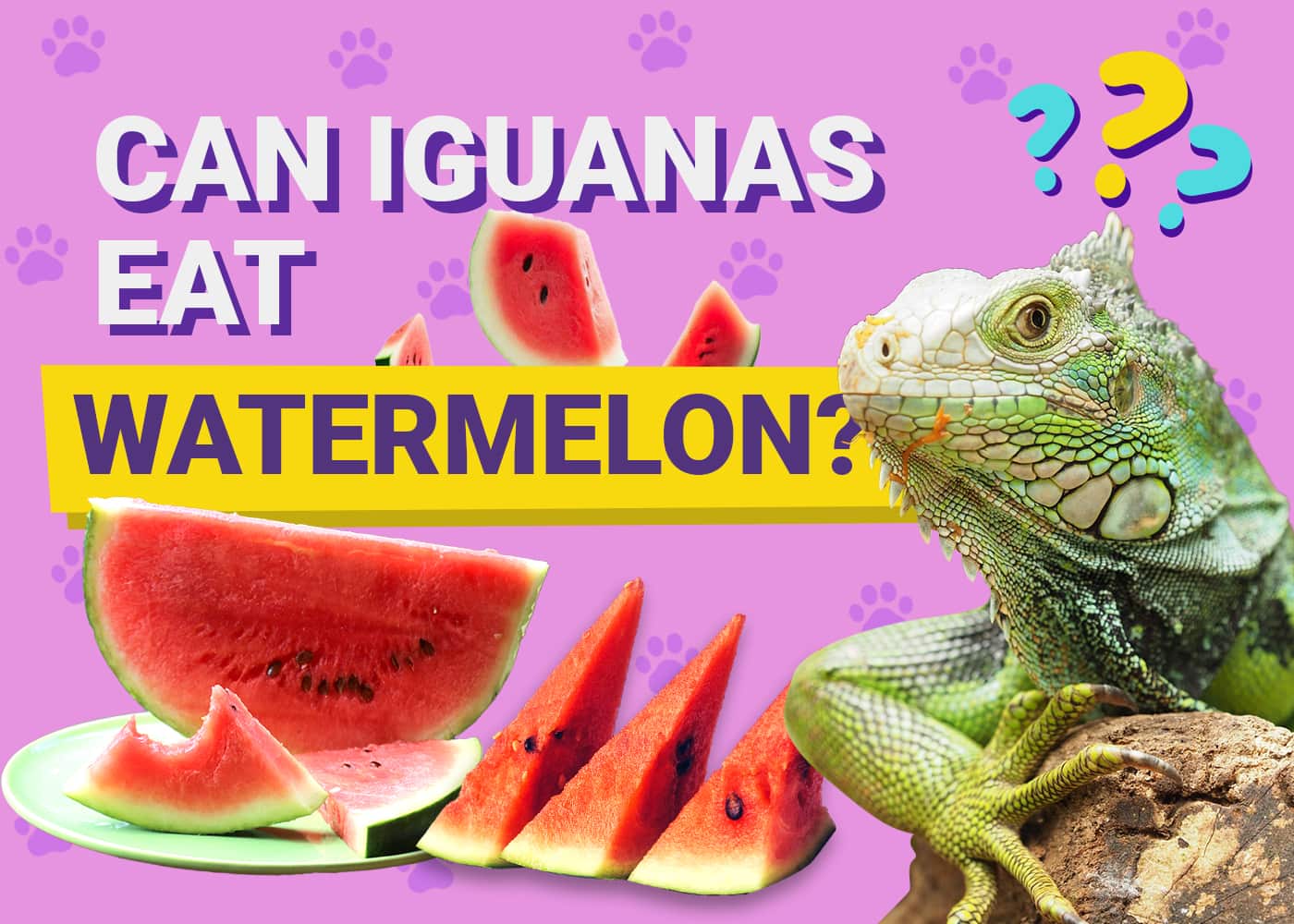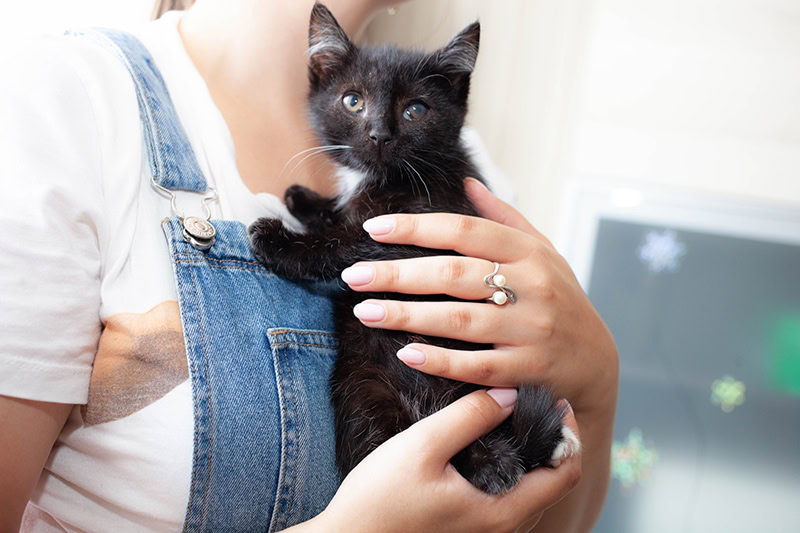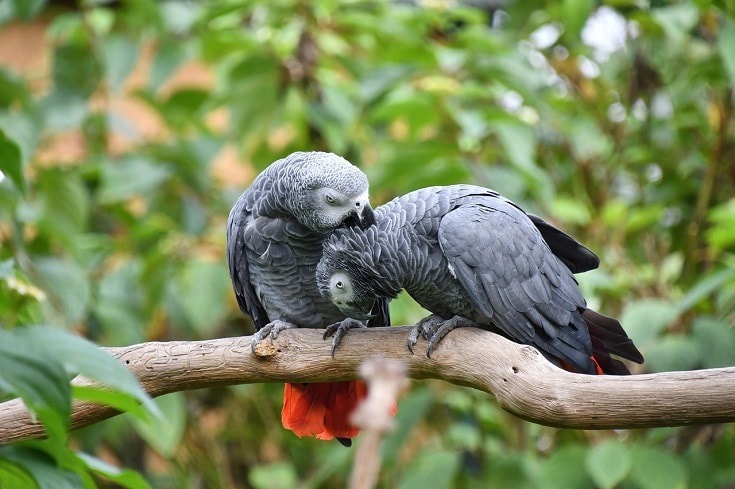VET APPROVED

The information is current and up-to-date in accordance with the latest veterinarian research.
Learn more »Click to Skip Ahead
The iguana is a fascinating and intriguing animal that has captured the hearts of many reptile enthusiasts; indeed, they are now a very popular pet in many homes. Whether bright green or dark in color, their appearance makes the iguana an atypical and remarkable companion. But to keep them healthy and happy, one of the most important things to consider is their diet.
While the bulk of an iguana’s diet should consist mainly of leafy greens, vegetables, and fruits, can you give your iguana watermelon? The answer is yes, but only in small amounts and as an occasional treat, as it is a fruit high in sugar. Also, there are more exciting and nutritious fruits to feed your iguana, as you will find out as you read on.

Quick Overview
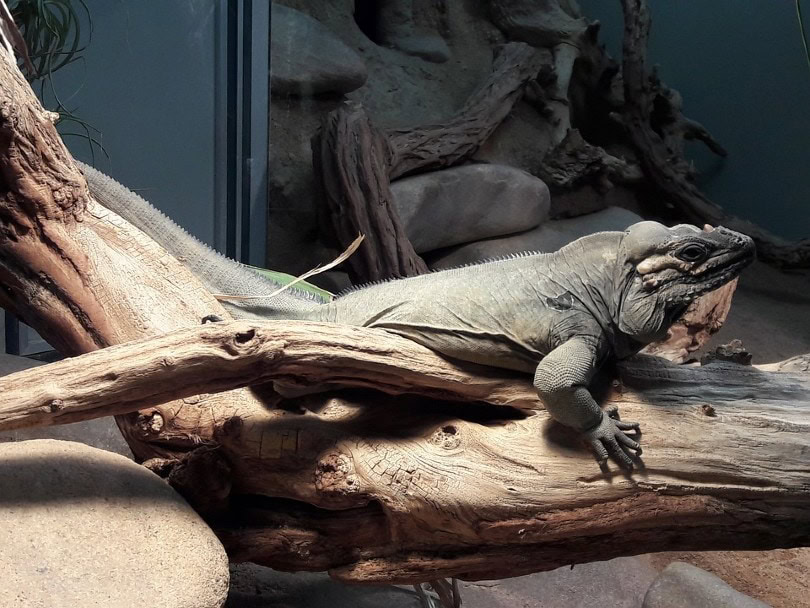
Before we delve deeper into the iguana diet, let’s take a look at their most important characteristics:
Iguanas comprise around 30 species of lizard, within 8 genera, from the Iguanidae family. When formulating diets, ensure you research the unique dietary requirements of your pet’s species.
The Green Iguana (Iguana iguana) is most often kept as a pet, so our article will focus on this species. Also, don’t be fooled by the name: the green iguana can take on a spectrum of colors, from dark greens and browns to lighter blues, lavender, and reds. Plus, this dragon-like reptile can grow up to 6 feet long, which is not to be overlooked when determining their living space in your home!
Finally, they can live up to 15 years, and some males can even exceed their twenties.
What Do Green Iguanas Eat in the Wild?
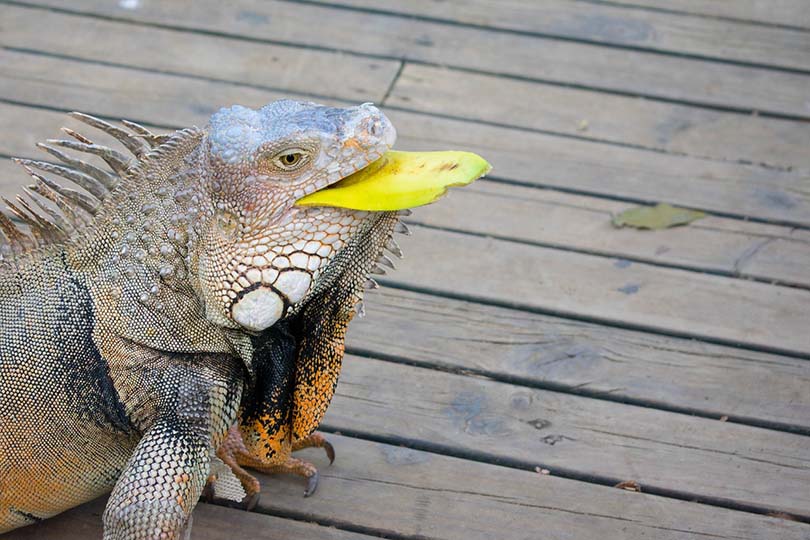
Green Iguanas are active during the day, feeding on leaves, flowers, and fruit. They are herbivorous and contain specialized microbes in their gut to help them digest food. If their environment is too cold the microbes won’t function as well, so ambient temperature plays an important role in the nutrition of this species.
78 to 98° F is ideal, with a temperature gradient so they can choose their preferred spot.
They do not use their legs to eat, but grab food with their tongues, taking small portions that they shred with their sharp teeth.
What Should You Feed Your Pet Green Iguana?
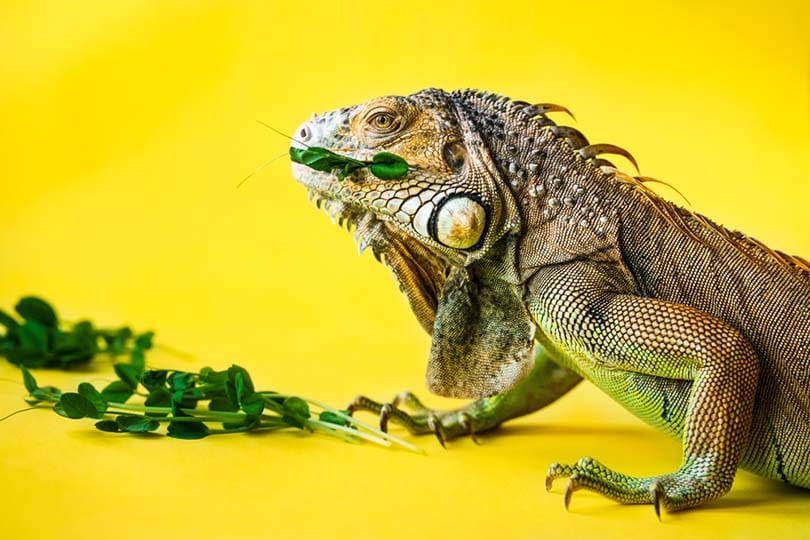
Contrary to what one might think, the Green Iguana does not eat meat. Thus, as a pet, their diet should consist of leafy greens, vegetables, and some fruits.
- 40–60% of the diet should be calcium-rich green leafy vegetables such as collard greens, mustard greens, dandelion, carrot tops, endive, and broccoli.
- 30–40% of the diet should consist of other vegetables in a variety of colors. Sweet potatoes, peas, okra, yellow squash, snow peas, and parsnips are good choices.
- Less than 20%, ideally around 10%, of the diet can be edible flowers and fruits as a treat. Watermelon is okay, but has more water than anything else so it does not add a great deal of value to their diet. The best choices include mango, figs, papaya, hibiscus, nasturtium, and rose petals.
Juvenile Green Iguanas may have slightly different nutritional requirements. Ingredients containing tannins, oxalic acid, and goitrogens should only be fed in small amounts as they can cause health problems.
Discuss your iguana’s diet with a veterinarian experienced in exotic animals if you are unsure.
You should supplement their diet with multivitamin powder specifically for this reptile, however, to avoid over-supplementation you should ask your veterinarian how much and how often to feed. Some people use a calcium supplement with or without phosphorus, as the ratio of these minerals is important. In addition, vitamin D is needed to metabolize calcium. Exposure to UV light is needed to make this vitamin so some pets may need it supplemented.
Ideal supplements will vary based on your pet’s sex, breeding status, and age among other things, so talk to your veterinarian if you’re not sure. Feeding a small amount of iguana pellets is optional.
What Is the Nutritional Value of Watermelon?
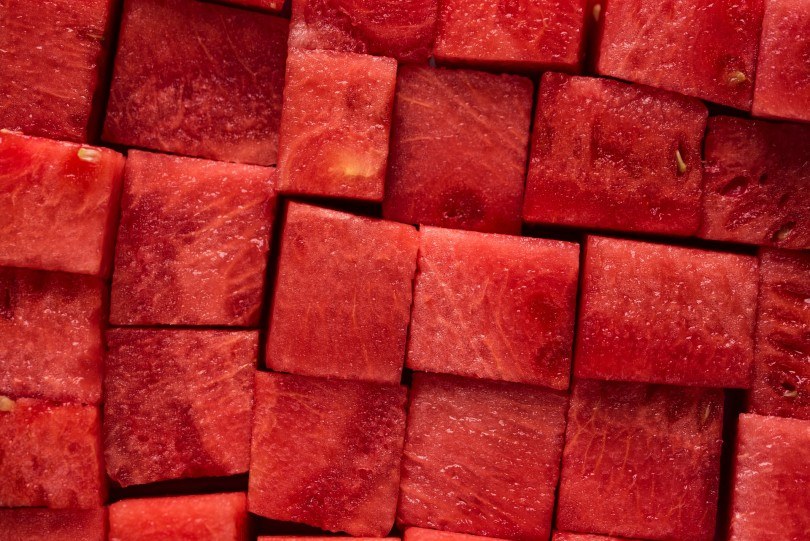
Watermelons contain only 30 kcal per 100 g. They are also composed of 91.4% water. While this fruit contains some vitamins and minerals, it has them in low concentrations. If your Green Iguana is filling up on watermelon, they are missing out on nutrients from other potential ingredients.
Despite this, the fruit has 6.2% sugar; while these pets love sugar, diets high in sugar have been shown to alter their glucose metabolism, which in humans leads to problems like diabetes.
A little piece of watermelon every now and then won’t do any harm. Your little dragon will also enjoy other tastier and more nutrient-dense fruits, such as apricots, figs, mangoes, raspberries, plums, bananas, kiwis, apples, pears, cantaloupe, strawberries, and dates.
What Foods Are Toxic to Iguanas?
Never feed your iguana human food that is not even good for you, such as french fries, cookies, pastries, chocolate, alcohol, caffeine, and candy. In addition, meat and animal proteins are to be avoided from his diet as they can cause kidney damage in excessive amounts.
Seeds from apples, apricots, cherries, nectarines, peaches and pears contain cyanide compounds and should not be fed. In addition, avocado, eggplant, rhubarb, rosemary, sage, azalea, buttercup, daffodil, lily of the valley, and tulip are toxic.
Bonus: Keeping the Green Iguana as a Pet
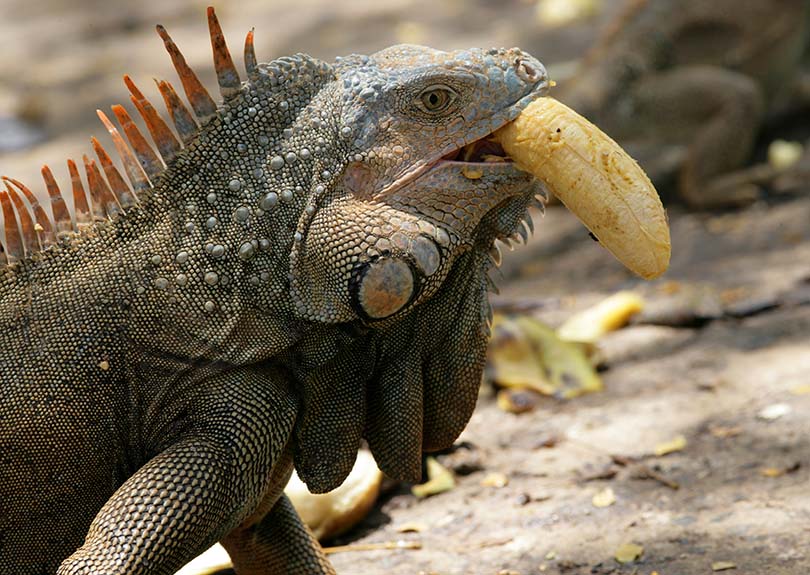
Green iguanas are only recommended for experienced reptile owners. There are three main reasons behind this warning:
- They can be aggressive. Indeed, once sexually mature, male iguanas can become territorial and quite dangerous, especially when handled by inexperienced owners.
- They can carry Salmonella. This type of bacteria can pose health risks to reptile owners and family members if good hygiene is not followed.
- They have high care requirements. Therefore, appropriate housing and nutrition should not be overlooked when caring for this reptile. Additionally, iguanas are prone to many health issues and can also be difficult to handle due to their size, towering tails, sharp teeth, and razor-sharp nails.
In short, the art of keeping a reptile healthy (and alive!) comes from understanding their needs. And as you will understand, the Green Iguana is an advanced-level reptile. Growing up to 6 feet long for adult males, requiring not a cage but an entire room to live in, not to mention the challenges of feeding, temperature, humidity, and exposure to ultraviolet rays, the Green Iguana is not your best choice for getting started with reptiles.


Final Thoughts
An iguana doesn’t need to eat watermelon to be healthy, but occasional small pieces with the seeds removed won’t hurt them. But beyond their diet, iguanas depend on external heat sources to maintain their body temperature, which optimizes their digestion.
Therefore, you will need to adhere to their optimum temperature range so that they can process the nutritious foods you offer them. Thus, by respecting these conditions, your iguana will have a better chance of living a longer and healthier life, and will appreciate even more the piece of watermelon that you give them!
- https://www.britannica.com/animal/iguana-lizard-grouping
- https://animaldiversity.orghttps://wpvet.com/wp-content/uploads/2021/03/green-iguana-diet.pdf
- https://myavho.com/storage/app/media/Iguana_Care_Card.pdf
- https://vcahospitals.com/know-your-pet/iguanas-feeding
- https://fdc.nal.usda.gov/fdc-app.html#/food-details/167765/nutrients
